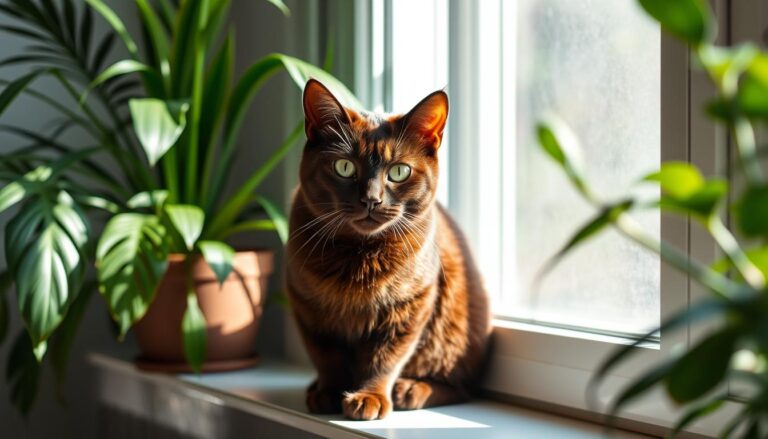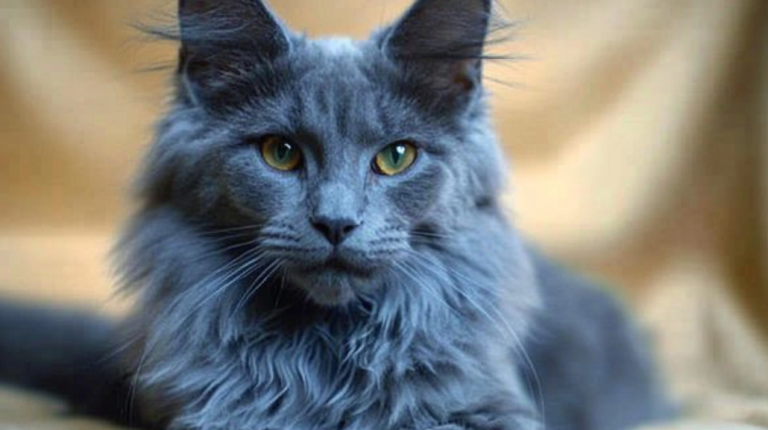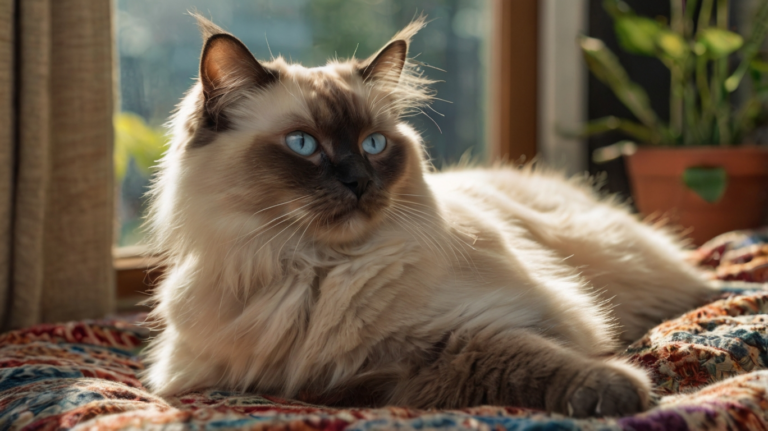British shorthair: 7 Remarkably Adorable Secrets You’ll Love
Introduction
Are you ready to meet one of the most beloved cat breeds in the world? If you have ever seen a plush, round-cheeked cat with an easygoing spirit, you have likely encountered a British shorthair. This breed has gained fans for its adorable looks, balanced personality, and charming quirks. But there is more to the British shorthair than meets the eye. Underneath that thick, velvety fur lies a cat with a fascinating history, remarkable social skills, and surprisingly low-maintenance grooming needs.
In the upcoming sections, you will learn why the British shorthair has captured hearts for generations and why it might just be the perfect fit for your family. We will explore the breed’s origins, personality traits, grooming routines, health considerations, and more. Plus, you will get useful tips on budgeting for a British shorthair, training and socializing your new furry friend, and figuring out what sets them apart from other popular cat breeds. By the end of this guide, you will feel fully informed—and possibly just a little starry-eyed—about this captivating cat. Let’s pounce right in!
A Brief History of the British Shorthair
The British shorthair is one of the oldest recognized cat breeds in the world, with roots that trace back to ancient Rome. Legend has it that Roman legions brought these sturdy cats to the British Isles to help control rodent populations. Over time, these felines adapted to the cool, damp climate and evolved to have thick, water-resistant coats, robust physiques, and calm temperaments. By the late 1800s, cat enthusiasts began to recognize the unique qualities of the British shorthair and helped formalize breed standards.
During the world wars of the 20th century, the British shorthair population suffered a significant decline. In response, breeders sought to diversify and strengthen the gene pool by introducing other cat types, including Persians. The result of these efforts was a re-established breed with an iconic round head, a plush double coat, and a personality that many describe as dignified yet affectionate.
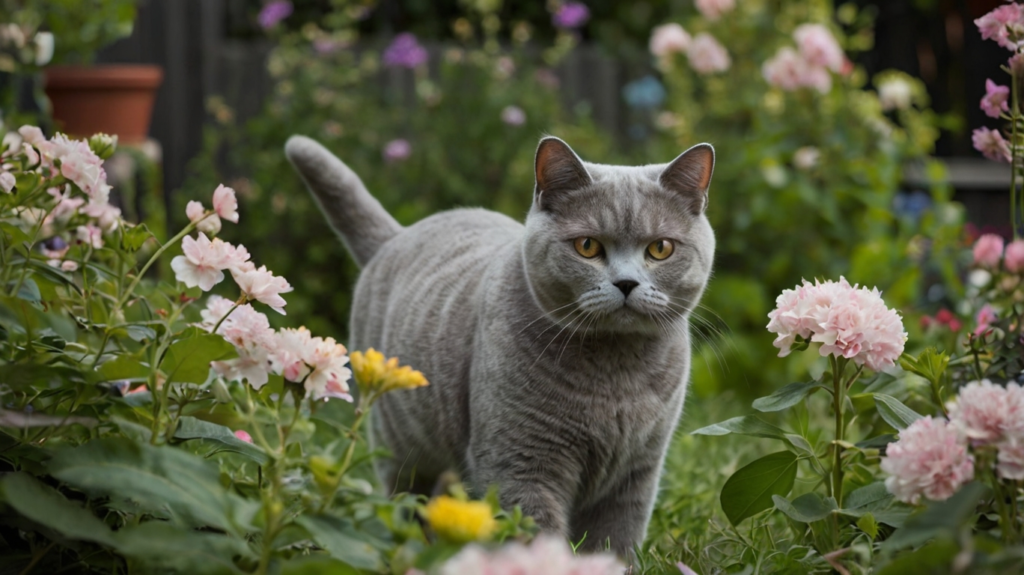
Today, the British shorthair is considered a cornerstone of the cat fancy, admired for its stable temperament, easygoing nature, and timeless good looks. In 1980, the breed was officially recognized by the Cat Fanciers’ Association (CFA), making it one of the most popular and respected pedigree cats worldwide. Whether you are drawn to their proud Roman roots or simply smitten with those round cheeks, the British shorthair’s heritage tells a story of resilience and enduring charm.
Physical Characteristics
When most people imagine a British shorthair, they picture a sturdy feline with broad shoulders, a thick neck, and a face as round as the moon. Indeed, the breed standard highlights its compact yet powerful build. British shorthairs typically weigh between 7 and 17 pounds, with males often larger and heavier than females. Their bodies are muscular but not overly lanky, and they should appear well-balanced from head to tail.
One of the most endearing features of the British shorthair is its plush double coat. This dense fur can come in a variety of colors and patterns, though the iconic “British Blue” is the most famous. The eyes are large and set wide apart, with colors ranging from copper to blue, depending on the coat color. Adding to the breed’s cuddly appeal are its full cheeks and rounded muzzle—some British shorthair fans even liken its face to a smiling teddy bear!
Coat Variations
- Solid Colors: Blue (most common), black, white, red, cream, and other hues
- Tabby Patterns: Classic, mackerel, spotted
- Tipped or Shaded: Chinchilla, shaded silver
- Tortoiseshell or Calico: Patches of black, red, white
Despite the coat’s thickness, British shorthairs are surprisingly easy to groom. Their plush fur naturally repels dirt, and a once-weekly brushing session is often enough to keep it looking glossy. This simplicity, combined with a regal bearing, means that the British shorthair often feels as good as it looks.
Personality and Temperament
The British shorthair temperament can best be described as balanced. These cats are confident yet not pushy, friendly but not clingy. They adore spending time with their families, but they are equally capable of relaxing in their favorite sunlit corner by themselves. If you are seeking a gentle, even-tempered companion who can cope with a variety of household situations, this breed might check all your boxes.
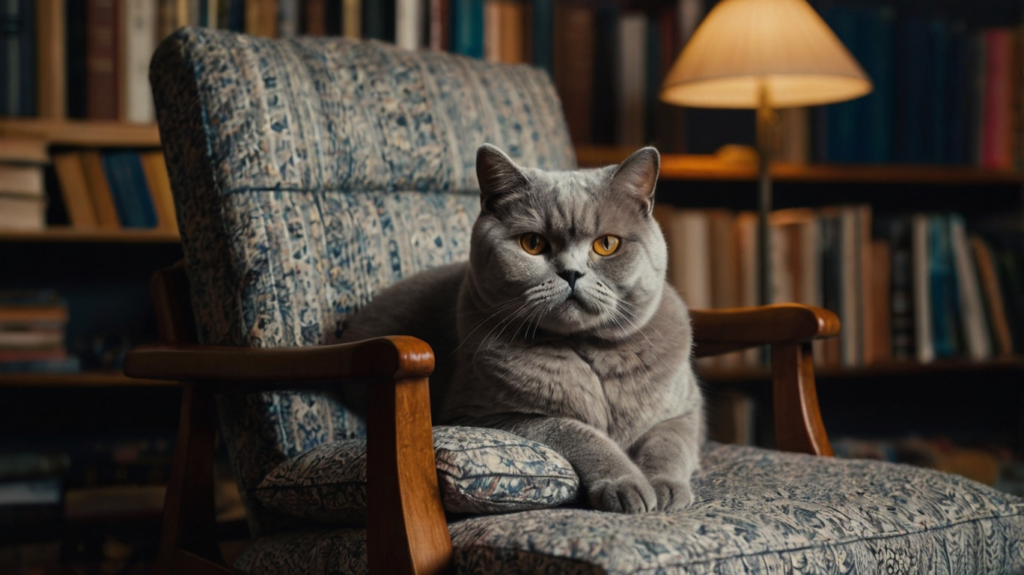
British shorthairs are known for:
- Calmness: They typically do not zoom around the house at odd hours—though they might indulge in an occasional playful sprint.
- Affection: While not lap cats in the classic sense, British shorthairs enjoy curling up next to you on the couch or following you from room to room.
- Adaptability: They adjust well to life with children, respectful dogs, or other cats. However, early socialization is key.
- Gentle Independence: They value their personal space but also crave companionship. Expect them to keep an eye on you from a close distance, sometimes trotting over to share a moment of cuddles.
These cats are not typically known for constant vocalization, though they might have a soft, sweet meow when they want attention. Also, do not be surprised to find your British shorthair calmly observing household activities from a favorite perch—like a wise old owl, they often enjoy watching the world go by.
Grooming and Care
Compared to some other breeds, the British shorthair has relatively modest grooming needs. However, maintaining a consistent routine can help keep your cat looking and feeling its best:
- Weekly Brushing
- Use a gentle brush or comb to remove loose hairs, especially during shedding seasons (spring and fall).
- It minimizes hairballs and maintains a glossy coat.
- Nail Trimming
- Regularly check your cat’s nails, trimming them if they become too long.
- Provide a scratching post to help manage nail wear naturally.
- Dental Care
- Dental hygiene is crucial for every cat, including a British shorthair.
- Talk to your veterinarian about pet-specific toothbrushes and toothpastes.
- Eye and Ear Checks
- Use a soft, wet cloth to carefully remove any particles near the eyes.
- Inspect the ears for signs of redness or wax buildup, and use veterinarian-approved ear cleaners if necessary.
Because British shorthairs typically have a short muzzle, they do not have as many brachycephalic health concerns as breeds like Persians. Still, it is wise to be mindful of environmental conditions—extreme heat or cold might make your cat uncomfortable. Overall, a simple grooming routine and close attention to your cat’s comfort will ensure your British shorthair remains in top form.
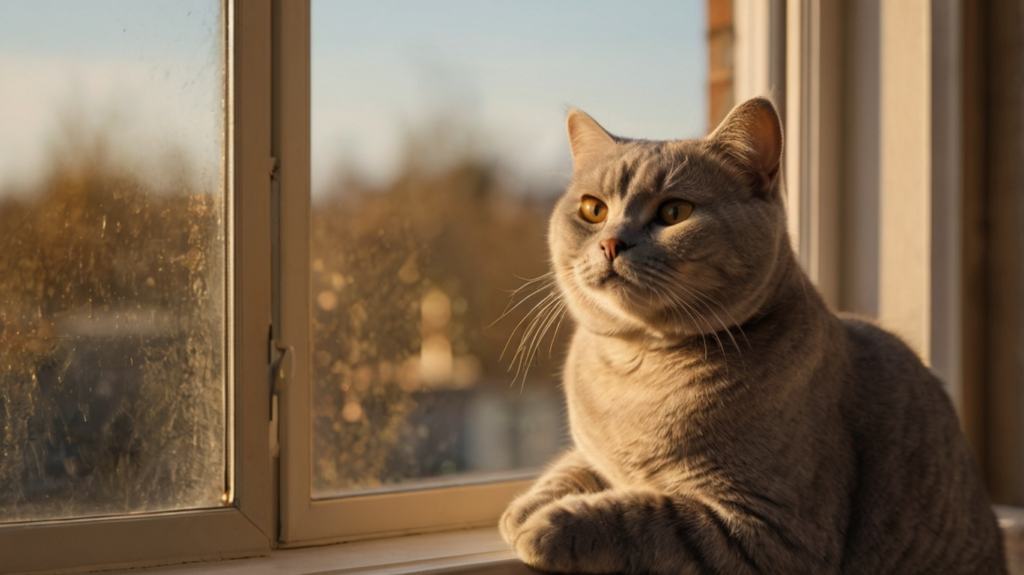
Feeding and Nutrition
All cats have individual dietary needs, but a British shorthair generally benefits from high-quality cat food formulated for its life stage. Whether you choose a commercial dry kibble, wet food, or a combination of both, focus on balanced nutrition that prioritizes high-quality animal proteins. Some British shorthairs may have a tendency to gain weight if overfed, so portion control is essential.
Key Dietary Tips
- Life Stage Diets
- Kittens need extra calories and nutrients for growth.
- Adult British shorthairs do best on standard adult formulations.
- Senior cats may need specialized diets that nurture their joints and keep them moving freely.
- Protein Content
- Choose cat food where real meat or fish is at the top of the ingredient list.
- Avoid fillers or excessive carbohydrates.
- Hydration
- Encourage water intake through multiple water bowls or a pet fountain.
- Wet food can boost hydration levels, especially for cats that do not drink much.
- Treats and Extras
- Limit treats and table scraps to avoid obesity.
- Use treats strategically, such as for training or rewarding good behavior.
If you suspect your cat has specific dietary sensitivities or if you notice any sudden changes in appetite or weight, consult your veterinarian for tailored advice. Remember, the information here is not a substitute for professional guidance, particularly for sensitive health cases.
Health and Common Concerns
Like any pedigree breed, the British shorthair can be susceptible to certain health conditions. Trusted breeders verify family histories and guarantee the health of their kittens. However, all cats benefit from regular veterinary checkups, preventive care, and a health-conscious lifestyle.
Potential Health Issues
- Hypertrophic Cardiomyopathy (HCM)
- A heart condition in which the muscle becomes abnormally thick.
- Breeding cats are often screened to reduce the risk of passing on HCM.
- Polycystic Kidney Disease (PKD)
- Formation of fluid-filled cysts in the kidneys.
- Early detection and management can help your cat live a longer, healthier life.
- Obesity
- British shorthairs can be big eaters. Overfeeding may lead to weight gain, which stresses joints and internal organs.
- Monitor calorie intake and encourage gentle exercise to maintain a healthy weight.
- Joint Issues
- While not exceedingly common, carrying extra weight can lead to joint stress.
- Provide soft bedding and moderate physical activities for better joint health.
Your British shorthair should have routine veterinary visits for vaccinations, parasite control, and overall health evaluations. Many of these health risks can be minimized through responsible breeding, early diagnosis, and a proper diet and exercise regimen. If you want more information on general cat care guidelines, you can refer to the ASPCA’s official resources for trustworthy advice.
Costs and Budgeting
A British shorthair is often more expensive to purchase than many other cat breeds, particularly when acquired from a reputable breeder. Keep in mind,The real total cost of ownership involves much more than what you pay upfront. By planning your budget in advance, you can ensure that you are prepared for the ongoing costs of quality food, veterinary care, and other necessities.
Typical Expenses
| Expense Category | Estimated Range | Frequency |
|---|---|---|
| Initial Purchase | $1,000 – $2,000+ | One-time (breeder fees) |
| Adoption (if lucky) | $100 – $300 | One-time (rescue fees) |
| Spay/Neuter | $100 – $300 | One-time (if not included) |
| Vaccinations | $50 – $100 | Annual/As recommended |
| Routine Vet Care | $100 – $300 | Annual |
| Food & Treats | $25 – $70/month | Ongoing |
| Pet Insurance | $15 – $40/month | Ongoing |
| Grooming Supplies | $20 – $50 | As needed |
| Misc. (toys, bed) | $50 – $100 | As needed |
Keep in mind that these figures are averages and can vary based on factors like your location, your cat’s overall health, and the quality of products you choose. For example, if you opt for premium, grain-free kibble or a specialized wet food diet, your monthly costs for food may be higher. Likewise, advanced medical tests or treatments can quickly add to veterinary bills.
When considering the overall expense of a British shorthair, be prepared for both the predictable and the unexpected. Setting aside an emergency fund or investing in pet insurance can help cushion unforeseen costs.
Training and Socialization
Even though a British shorthair does not demand extensive training like some high-energy breeds, gentle socialization and basic commands go a long way toward a harmonious household. Fortunately, British shorthairs are intelligent and eager to please, especially if you use positive reinforcement methods.
Basic Tips for Training
- Socialize Early
- Expose your cat to various sights, sounds, people, and pets while they are young.
- Positive, low-stress experiences help build a well-adjusted adult cat.
- Positive Reinforcement
- Offer treats, praise, or gentle strokes to reinforce positive actions.
- Avoid punishment, which can break trust.
- Litter Box Training
- Most British shorthair kittens learn litter box habits from their mothers.
- Keep the box spotless and position it where your cat feels comfortables.
- Encourage Play
- Short play sessions with interactive toys help your cat burn off energy.
- This also reinforces the bond between you and your cat.
- Discourage Scratching on Furniture
- Offer scratching posts or pads at strategic locations.
- Use positive reinforcement when your cat chooses the proper place to scratch.
A well-socialized British shorthair is typically confident and relaxed around visitors, children, and other pets, making them an excellent addition to families of all shapes and sizes. If you want to learn more about multi-cat households, check out [INTERNAL LINK 1]. This resource can shed light on introducing a new cat to an existing feline family.
Finding Your British Shorthair
When you are ready to welcome a British shorthair into your home, you have several options. Responsible breeders invest in the health and temperament of their cats, perform genetic testing, and typically provide health guarantees. Adoption is another route—occasionally, British shorthairs become available through breed-specific rescues or general shelters.
Breeder Considerations
- Ask to meet the kitten’s parents if possible, so you can observe their temperament and living conditions.
- A reputable breeder will answer your questions about health clearances, lineage, and training tips.
- Expect a waiting list if the breeder is popular—this can be a good sign of quality over quantity.
Adoption and Rescue
- Check local shelters, rescue groups, and online listings for adult British shorthairs in need of new homes.
- Be prepared for an adjustment period—rescued cats may need extra patience as they settle in.
- Adoption fees typically include spay/neuter and basic veterinary care, making it a cost-effective and compassionate choice.
Choosing the right cat is a personal decision that depends on your lifestyle, budget, and expectations. Whichever path you choose, you are investing in a lovable companion who can bring joy for many years to come.
British Shorthair vs. Other Breeds
Though many cat lovers are charmed by the British shorthair, you might wonder how it compares to other popular breeds like the Maine Coon, Ragdoll, or Siamese. While each breed has its unique traits, the British shorthair’s hallmark qualities include a plush coat, gentle independence, and mellow personality.
Below is a quick table summarizing how a British shorthair stacks up against a few other well-known cat breeds:
| Breed | Coat Type | Typical Personality | Activity Level |
|---|---|---|---|
| British Shorthair | Plush double coat | Calm, dignified, affectionate | Moderate (enjoys bursts of play) |
| Maine Coon | Long, shaggy | Friendly, social, playful | Moderate to high |
| Ragdoll | Soft, semi-long | Docile, lap-friendly | Low to moderate |
| Siamese | Short, fine | Vocal, curious, sociable | High |
This comparison table can help you visualize some of the main differences in coat type, temperament, and energy level. If you want to dive deeper into breed-specific traits, you can also refer to [INTERNAL LINK 2], [INTERNAL LINK 3], or [INTERNAL LINK 4] for more detailed resources.
FAQs
Why does a British Shorthair often cost more?
A British shorthair usually costs more because of careful breeding practices, genetic screening, and high demand. Breeders invest in health checks and proper care, which influences the price. You are paying for a well-raised, healthy companion.
Does a British Shorthair prefer living indoors?
A British shorthair adapts very well to indoor living, thanks to its calm and relaxed nature. While some enjoy supervised outdoor time, they do not require wide roaming. Providing a stimulating indoor environment is usually enough for a happy British shorthair.
What is so special about a British Shorthair?
A British shorthair stands out for its round face, plush coat, and balanced temperament. They blend independence and affection, making them versatile companions. Their calm demeanor allows them to adapt to various households with ease.
Conclusion
From its origins in the Roman era to its modern-day status as a beloved family companion, the British shorthair has earned its reputation as a steadfast and charming cat. Its round face, plush coat, and easygoing demeanor have captivated cat lovers across the globe. While they can be a bit pricier to acquire, responsible ownership includes budgeting for quality nutrition, regular veterinary care, and an enriching environment that meets both physical and emotional needs.
If you are considering adding a British shorthair to your family, remember the importance of early socialization, routine grooming, and consistent vet checkups. In return, you will enjoy years of calm companionship and gentle affection from this adorable feline. Feel free to share your British shorthair stories or ask additional questions in the comments below—community support is a wonderful part of the cat ownership journey!


